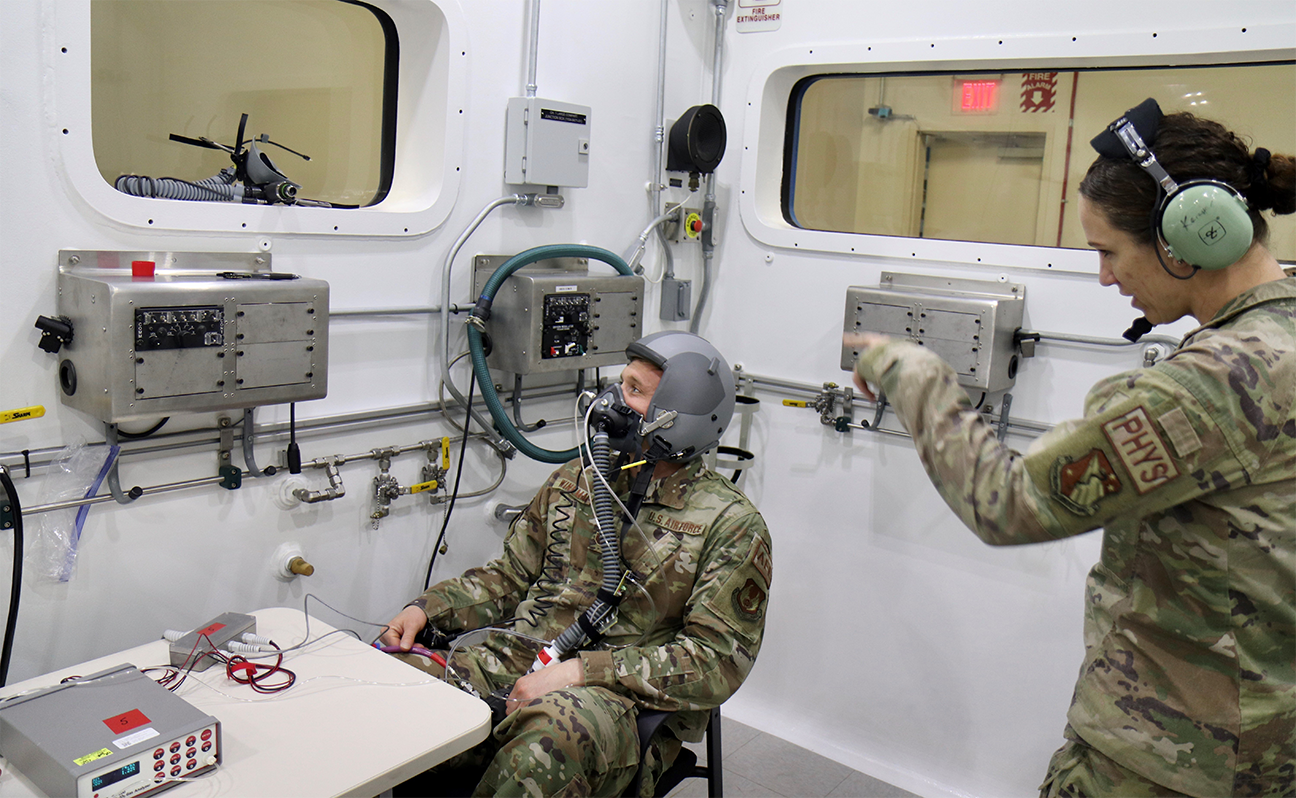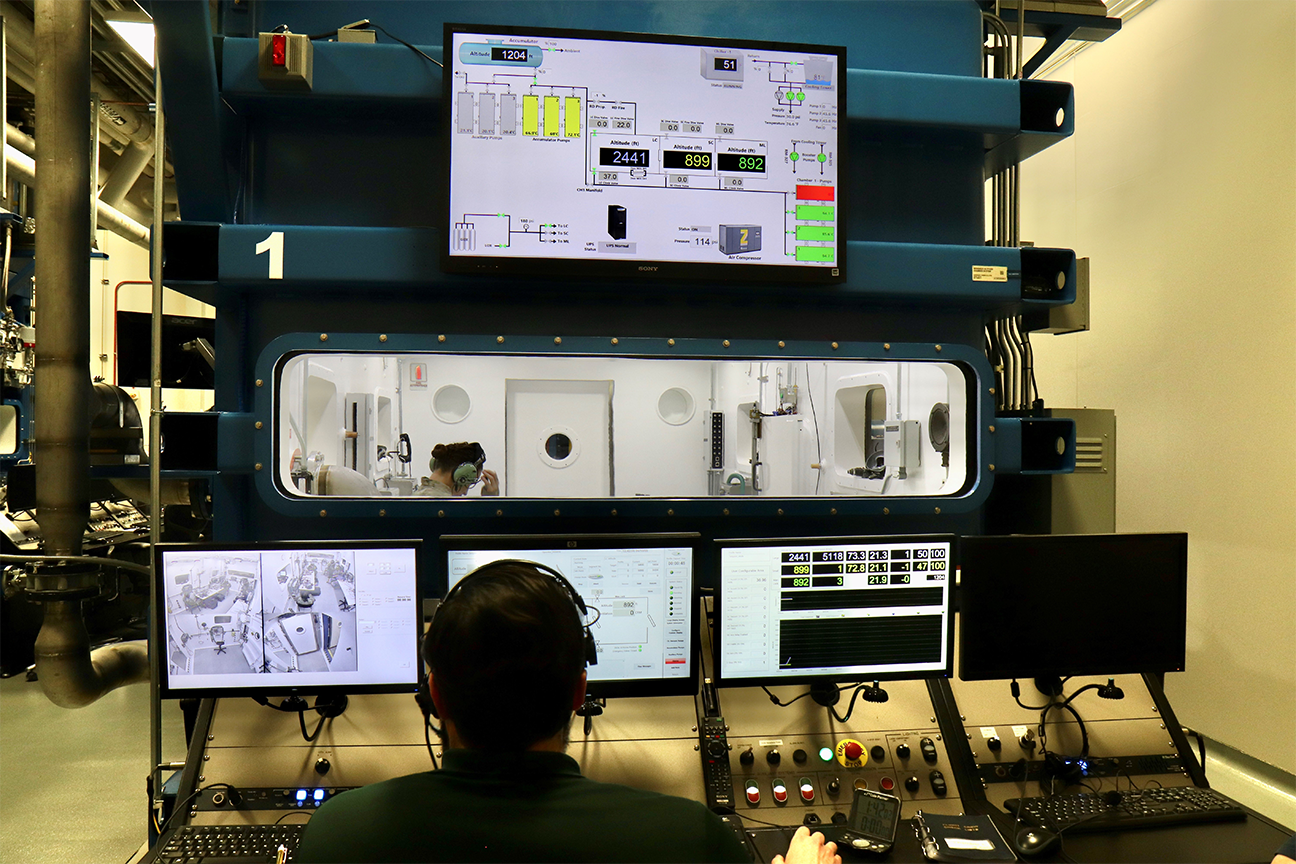WRIGHT-PATTERSON AIR FORCE BASE, Ohio (AFRL) — There’s only one place to find them in all the Department of Defense, and that’s at the Air Force Research Laboratory.
Three of the lab’s Research Altitude Chambers, better known as the RACs, are now certified for manned research up to 50,000 feet. No other chambers in the DOD have the same man-rating certification. It’s a feat not easily found elsewhere as well, according to Maj. Sarah Kercher, an aerospace physiologist for the lab’s 711th Human Performance Wing.
“The RACs have one-of-a-kind capability for the DOD, housed right here at Wright Patterson,” Kercher said. “As for the civilian enterprise, multiple altitude chambers exist, at NASA, universities, and contractor facilities, but when it comes to conducting human research, the numbers dwindle, and even more so when you look at the capabilities that each research chamber can provide.”
The certification comes at a time when it has never been needed more. Air Force technology is rapidly pushing the limits of altitude capabilities for manned flight, and the sky obviously has no limits for AFRL’s other main client, the Space Force.
Dr. Lloyd Tripp Jr. led a team of AFRL and Naval Medical Research Unit Dayton (NAMRU-D) scientists and engineers to complete the engineering and safety assessment process. Tripp is the aerospace physiology research lead for the 711 HPW with more than 40 years of aviation research experience.
“We need to make sure our facilities are operationally safe,” he told leadership when the 711 HPW took ownership of the unique chambers, knowing other DOD agencies would have a keen interest in them if the technical and safety certification was carefully authenticated.
Tripp’s team achieved its first altitude certification goal, 50,000 feet, in March.
“It is important that this was done correctly,” Tripp said. “Safety is always our number one priority.”
The team worked hard to keep certification ahead of schedule, Kercher said, despite equipment and personnel availability challenges. And that work is not over.
Another piece of equipment due to arrive soon should send the manned rating even higher. Certification at 60,000 feet is expected in “the very near future,” Kercher said. That mark will hold particular value to the Guardians of the Space Force, she added, “as they make their way into the future, exploring higher altitudes than previously needed by Air Force counterparts.”
All three chambers are expected to make the jump to 60,000, but each with different capabilities and purpose. RAC 1 holds up to 20 people for studies typically focused on hypoxia (lack of oxygen to the brain), decompression sickness, and human performance at high altitude.
RAC 2 was designed with lots of space in mind. It’s the chamber for large equipment, up to the size of a Humvee, and aircraft life support systems studies. Its testing temperatures range from 150 F to -67 F, and like RAC 1, the second chamber can simulate an altitude as high as 100,000 feet for testing equipment without people inside.
Kercher envisions the capability beyond 60,000 feet to lure the type of plans currently on NASA and Space Force drawing boards. The kind that has the arms and motion to fix a satellite, for example, but isn’t human.
“We can put those robots, or similar equipment, in our chamber to see if they still work at those increased altitudes and extreme cold temperatures,” Kercher said.
AFRL’s third RAC is designed more with humans in mind, like RAC 1, and its specialty is rapid decompression, in as fast as 0.04 seconds, with qualified participants inside. RAC 3 is also temperature-controlled and suited for other research.
Sitting next to RAC 3 at the lab is what could be called the little brother of the bunch, a much smaller RAC 4, used for rapid decompression on small equipment. Think cell phones, medical equipment, computers, and the like. Measuring just 45 cubic feet, RAC 4 is not intended for humans, but it packs the same punch as its bigger siblings with an altitude ceiling of 100,000 feet.
The four young RACs join a growing family of cutting-edge technology at Wright Patterson, creating an epicenter of aerospace physiology research. Housed under the same roof is the Air Force’s only human-rated centrifuge, considered to be the world’s most advanced after it officially opened in 2018.
Residing nearby is the KRAKEN. Unleashed in 2016, and developed by AFRL’s partnering NAMRU-D, KRAKEN is a 245,000-pound monster machine that can create motion on six axis to simulate spatial disorientation.
A smile came to Tripp’s face when he recalled the day KRAKEN was first shown to the media with much fanfare, complete with music from the movie “Pirates of the Caribbean.” The RACs opened with less pizazz, admittedly, but Tripp’s smile went even bigger when he talked about the type of research they will house after he retires.
“This is a really exciting time,” he said. “It makes we wish I was a little bit younger.”

Maj. Sarah Kercher directs Tech. Sgt. Tyler Wineman in preparation for an oxygen system test inside a Research Altitude Chamber at Wright Patterson Air Force Base, Ohio, April 15, 2022. The chamber is one of three at the base that were certified in March for manned research up to 50,000 feet, a benchmark found nowhere else in the Department of Defense. Wineman is an aircrew flight equipment research technician and Kercher is an aerospace physiologist. Both are assigned to the 711th Human Performance Wing, the Air Force Research Laboratory unit that operates the chambers. (U.S. Air Force photo/Jason Schaap)

Tech. Sgt. Tyler Wineman waits for an oxygen system test to begin inside a Research Altitude Chamber at Wright Patterson Air Force Base, Ohio, April 15, 2022. The chamber is one of three at the base that were certified in March for manned research up to 50,000 feet, a benchmark found nowhere else in the Department of Defense. Wineman is an aircrew flight equipment research technician assigned to the 711th Human Performance Wing, the Air Force Research Laboratory unit that operates the chambers. (U.S. Air Force photo/Jason Schaap)

The inside activities of Research Altitude Chamber 1 are monitored from the outside during an oxygen system test at Wright Patterson Air Force Base, Ohio, April 15, 2022. The chamber is one of three at the base that were certified in March for manned research up to 50,000 feet, a benchmark found nowhere else in the Department of Defense. (U.S. Air Force photo/Jason Schaap)

Tech. Sgt. Tyler Wineman sits inside a Research Altitude Chamber during an oxygen system test at Wright Patterson Air Force Base, Ohio, April 15, 2022. The chamber is one of three at the base that were certified in March for manned research up to 50,000 feet, a benchmark found nowhere else in the Department of Defense. Wineman is an aircrew flight equipment research technician assigned to the 711th Human Performance Wing, the Air Force Research Laboratory unit that operates the chambers. (U.S. Air Force photo/Jason Schaap)

Equipment up to the size of a Humvee can fit inside Research Altitude Chamber 2 at Wright Patterson Air Force Base, Ohio. The Air Force Research Laboratory operates four RACs at the base and three were certified in March, 2022, for manned research up to 50,000 feet, a certification found nowhere else in the Department of Defense. (U,S. Air Force photo/Jason Schaap)

